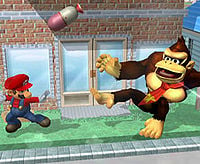Grab release
Grab releasing is a technique similar to chain grabbing, except the user releases the victim rather than throwing them. There are two sorts of grab releases, ground releases and air releases. Ground releasing is an opponent sliding a short distance from the grabber. Air releasing is an opponent is being sent in the air after being released from a grab, and varying on the character, is able to take control at varying times. Grab releases are mostly abused in Brawl since the amount of time before a released character can act is usually too late for a follow-up attack can be prevented. In Brawl, characters can escape via ground release or air release (In Melee, the player can move left or right while being air released), depending on which they experience more time to escape. Some characters can force a ground release on their opponent based on the speed of their pummel. Characters can also force an air release smaller characters, due to their size, are unable to force jump breaks to large characters or some small characters even other small characters as they grab too close the ground while large sized characters can usually force a jump break to smaller characters since. For example, only Snake and Yoshi can force Donkey Kong to jump break as he is large enough to have his feet on the ground unless he is in the edge of a stage.
In Brawl, if a character escapes via a ground release, they experience 30 frames of lag and land close-by on the ground (excluding Donkey Kong, Ness, and Lucas). If it is an air release, the user experiences 30 frames of lag and the victim suffers 50 frames of lag (does not apply to Jigglypuff). In Melee, every character has the same amount of frames of grab release lag, ground release lag, and air release lag (excluding Bowser's grab release lag, which is 10 frames shorter than the other characters and Donkey Kong's ground release lag, which is 9 frames shorter than the other characters).
Grab release combos come into existence when a character has either a very short distanced air release such as in Brawl, Wario, who is released vertically up, and Meta Knight, who has extremely low aerial movement, or experiences additional lag from a ground release, such as Ness and Lucas. Others, like Fox and Falco, cannot do anything when released until they reach the ground, making them suffer less frames. In Melee, Bowser has just enough frames to regrab the opponent after a ground release.
Exceptions
In Melee
Bowser's grab release is 10 frames shorter than other characters and Donkey Kong's ground release is 9 frames shorter than other characters.
In Brawl
When ground released, both Ness and Lucas suffer from 40 frames of lag rather than the normal 30. This gives any opponent 10 frames to do almost anything they want to them. Since Bowser and Donkey Kong (when using his cargo release) only suffer 20 frames of lag after releasing an opponent, they have 20 frames to attack Ness or Lucas during their release.
When ground released, Donkey Kong suffers from only 20 frames of lag, rather than the normal 30, so he has 10 extra frames to counterattack the opponent.
When Bowser ground or air releases an opponent, Bowser only suffers from 20 frames of lag, allowing him to chaingrab or attack out of any grab release.
When Jigglypuff is air released, it only suffers from 49 frames of lag, allowing it an extra 1 frame to attack out of an air release. This allows it to use Rest if the opponent gets close enough, though this is rather impractical during an actual match.
Some characters like Fox, Falco, or Sheik have a normal ground release animation, but when air released they reach the ground very early due to their high falling speed. This allows them to cancel the short amount of time they have of their air release animation with their landing animation giving them an extra frame or two to escape.
Wario, who is known for having serious grab release issues, experiences the lag of most characters during his ground release. His air release, however, does not send him any horizontal distance at all, leaving him extremely vulnerable for 20 frames in front of the opponent. This causes him to be the prime target for many grab release combos, and possibly even infinites for those who can force him to jump break.
Controversy
Many have argued about whether grab releases should be allowed in competitive play, since they usually much more potent than most chaingrabs, they usually end up as infinites or 0-deaths on the victim.
Well known grab releases are Marth's grab release 0-death on Ness and Lucas, Zero Suit Samus' infinite on Squirtle, and Yoshi's infinite on Wario.
It is unknown why Ness, Lucas, Jigglypuff, Donkey Kong, and Bowser all have different grab release times than the rest of the cast. Most people believe it was to "nerf" or "buff" them intentionally, but this can never be proven.
